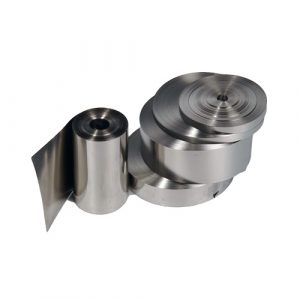
Introduction
The iron-based nanocrystalline alloy is an amorphous material formed by a rapid solidification process of an alloy composed of a small amount of Nb, Cu, Si, and B elements. The amorphous material is heat treated. It can be obtained as a diameter, dispersed on an amorphous matrix, and is called a microcrystalline, nanocrystalline material or nanocrystalline material. The crystallite diameter is 10-20 nm, and the applicable frequency range is 50Hz-100kHz
Performance characteristics
1,Nanocrystalline materials have excellent integrated magnetic properties: high saturation magnetic induction (1.2T), high initial magnetic permeability (8×104), low Hc (0.32A/M), low frequency loss under high magnetic induction (P0 .5T/20kHz=30W/kg), the resistivity is 80μΩ/cm, which is higher than that of permalloy (50-60μΩ/cm). High or high Br (0.9) or low Br (1000Gs) can be obtained by longitudinal or transverse magnetic field treatment. ). It is the best comprehensive material on the market today::, the best frequency range: 20kHz-50kHz. Widely used in high-power switching power supply, inverter power supply, magnetic amplifier, high-frequency transformer, high-frequency inverter, high-frequency choke core, current transformer core, leakage protection switch, common mode inductor core
2,The magnetic permeability and Hc value of the nanocrystalline alloy are close to the crystalline high permalloy and cobalt-based amorphous, and the saturation magnetic induction Bs is equivalent to the medium nickel permalloy. The heat treatment process is simple, and it is an ideal low-cost high-performance soft magnetic. Materials; although the Bs value of nanocrystalline alloys is lower than that of iron-based amorphous and silicon steels, their high frequency loss under high magnetic induction is much lower than them, and has better corrosion resistance and magnetic stability. Compared with ferrite, nanocrystalline alloys have a working magnetic induction of 2 to 3 times higher than that of lower loss at 50 kHz, and the core volume can be more than doubled
Application
Iron-based nanocrystalline soft magnetic materials are widely used in power frequency transformer cores, saturated chokes, high frequency transformers and magnetic heads. Recently, the next-generation information storage device made of the giant magnetoresistance effect of iron-based nanocrystalline soft magnetic material has greatly increased the storage density, reduced the volume and weight of the storage device, and made green using its magnetic refrigeration effect. The refrigerator 0 avoids the use of harmful Freon and protects the environment. In addition, there are also huge application prospects in ISDN cores, sensors, common mode chokes, and magnetic shields.
Advantages
1,High saturation magnetic induction: The Bs of iron-based nanocrystalline alloys is 1.2T, which is more than twice that of ferrite. As a common mode inductor core, an important principle is that the core cannot be magnetized to saturation, otherwise the inductance is drastically reduced. In practical applications, there are many occasions with high interference intensity (such as high-power variable frequency motor). If ordinary ferrite is used as a common mode inductor, the core may be saturated, and it cannot guarantee the interference under high intensity. Noise suppression effect. Due to the high saturation magnetic induction strength of nanocrystalline alloys, its anti-saturation characteristics are undoubtedly better than ferrites, making nanocrystalline alloys very suitable for applications with high current and strong interference
2,High initial permeability: The initial magnetic permeability of nanocrystalline alloys can reach 100,000, which is much higher than that of ferrites. Therefore, common mode inductors made of nanocrystalline alloys have large impedance and insertion loss under low magnetic field, and weak interference. It has excellent inhibition. This is especially true for anti-weak interference common mode filters that require very small leakage currents. In some specific situations (such as medical equipment), the device causes leakage current through the capacitance to the ground (such as the human body), which is easy to form common mode interference, and the device itself is extremely strict. At this point, the use of high permeability nanocrystalline alloys to make common mode inductors may be the best choice. In addition, the high magnetic permeability of the nanocrystalline alloy can reduce the number of turns of the coil, reduce the distribution parameters such as parasitic capacitance, and thus increase the formant frequency on the insertion loss spectrum due to the distribution parameter. At the same time, the high magnetic permeability of the nanocrystalline iron core makes the common mode inductance have higher inductance and impedance value, or reduce the volume of the iron core under the premise of the same inductance
3,Excellent temperature stability: The Curie temperature of iron-based nanocrystalline alloys is as high as 570℃ or higher. In the case of large temperature fluctuations, the performance change rate of nanocrystalline alloys is significantly lower than that of ferrites, with excellent stability, and the change in properties is close to linear. Generally, the nanocrystalline alloy has a rate of change of the main magnetic properties within 10% in the temperature range of -50oC to 130oC. In contrast, the Curie temperature of ferrite is generally below 250oC, and the rate of change of magnetic properties sometimes reaches 100% or more, and it is nonlinear and difficult to compensate. This temperature stability of nanocrystalline alloys, combined with their unique low loss characteristics, provides device designers with relaxed temperature conditions. And Figure 3 shows the temperature characteristics of the saturation magnetic induction of different materials.
4,Flexible frequency characteristics: Through different manufacturing processes, nanocrystalline iron cores can obtain different frequency characteristics, and with different coil turns, different impedance characteristics can be obtained to meet the filtering requirements of different bands, and the impedance value is much higher than that of iron. Oxygen. It should be pointed out that any filter can not expect to achieve noise suppression over the entire frequency range with a core material, but should choose different core materials, sizes and turns according to the filter frequency band required by the filter. Compared with ferrite, nanocrystalline alloys can be more flexibly adjusted to obtain the desired frequency characteristics.
